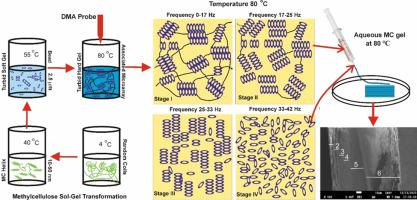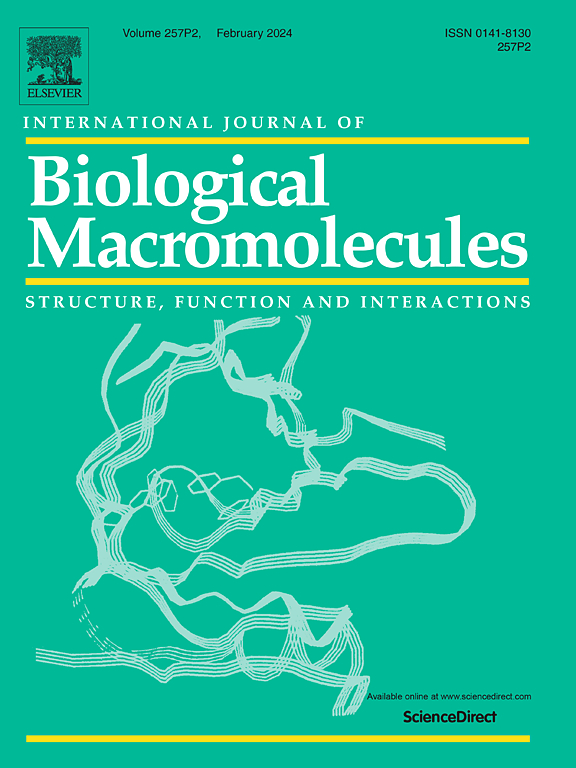Gelation and post-gelation mechanism of methylcellulose in an aqueous medium: 1H NMR and dynamic compressive rheological studies
IF 7.7
1区 化学
Q1 BIOCHEMISTRY & MOLECULAR BIOLOGY
International Journal of Biological Macromolecules
Pub Date : 2024-12-01
DOI:10.1016/j.ijbiomac.2024.137725
引用次数: 0
Abstract
Methylcellulose (MC) has become crucial in 3D bioprinting in the last decade. Researchers investigated MC aqueous solutions blended with biopolymers at room temperature, focusing on rheological studies. Even at low concentrations, the gel state of MC, which provides structural strength through hydrophilic and hydrophobic associations, was explored for injection-based 3D printability. Post-gelation phenomena were examined at 80 °C using a dynamic mechanical analyzer (DMA), revealing increased storage and loss moduli with frequency, indicating a robust gel network structure. Optical microscopy reveals that upon heating from 40 to 80 °C, the structural strength is enhanced via the formation of hydrophobic confirmations, starting from the micro-helical structure to the associated microarray. These microarrays are further synchronized to withstand the high frequency of the DMA probe. Compressive rheology outcomes allow us to elaborate on the possibility of injection-based 3D printability of aqueous MC gel at 80 °C. 1H and 13C NMR studies probed hydrophobic interactions among MC chains, showing evidence of H-bonding through temperature-dependent shifts. UV/Vis experiments traced gel formation, depicting a time-dependent network formation process. Overall experiments indicated that adjusting temperature could control gelation time, allowing precise tuning of the printing process and achieving fine layers (10 μm) in the printed membrane with maximum hydrophobic clusters.

甲基纤维素在水介质中的凝胶化和后凝胶化机制:1H NMR 和动态压缩流变学研究。
近十年来,甲基纤维素(MC)已成为三维生物打印的关键材料。研究人员调查了室温下与生物聚合物混合的 MC 水溶液,重点是流变学研究。即使在低浓度下,MC 的凝胶状态也能通过亲水和疏水结合提供结构强度,研究人员探索了基于注射的三维打印性。使用动态机械分析仪(DMA)对 80 °C 时的凝胶后现象进行了研究,结果表明,随着频率的增加,存储模量和损失模量也在增加,这表明凝胶网络结构非常坚固。光学显微镜显示,从 40°C 加热到 80°C 时,通过形成疏水确认,从微螺旋结构到相关的微阵列,结构强度得到增强。这些微阵列进一步同步化,以承受 DMA 探针的高频率。压缩流变学结果使我们能够详细说明水性 MC 凝胶在 80 °C 下注射式三维打印的可能性。1H 和 13C NMR 研究探究了 MC 链之间的疏水相互作用,通过温度依赖性偏移显示了 H 键的证据。UV/Vis 实验追踪了凝胶的形成,描绘了一个随时间变化的网络形成过程。总体实验表明,调节温度可控制凝胶化时间,从而精确调整打印过程,并在打印膜中形成具有最大疏水簇的细层(10 μm)。
本文章由计算机程序翻译,如有差异,请以英文原文为准。
求助全文
约1分钟内获得全文
求助全文
来源期刊
CiteScore
13.70
自引率
9.80%
发文量
2728
审稿时长
64 days
期刊介绍:
The International Journal of Biological Macromolecules is a well-established international journal dedicated to research on the chemical and biological aspects of natural macromolecules. Focusing on proteins, macromolecular carbohydrates, glycoproteins, proteoglycans, lignins, biological poly-acids, and nucleic acids, the journal presents the latest findings in molecular structure, properties, biological activities, interactions, modifications, and functional properties. Papers must offer new and novel insights, encompassing related model systems, structural conformational studies, theoretical developments, and analytical techniques. Each paper is required to primarily focus on at least one named biological macromolecule, reflected in the title, abstract, and text.

 求助内容:
求助内容: 应助结果提醒方式:
应助结果提醒方式:


